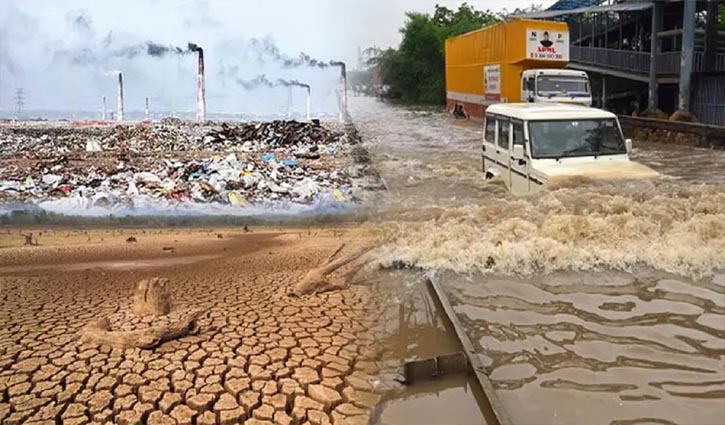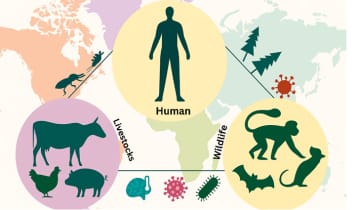Climate change threatens to destabilize the global economy
Hasan Mahmud || risingbd.com

Caption: Picture Collected
Climate change is not just an environmental problem; it affects financial stability through reduced income and property damage. Climate risk can certainly pose financial risks. But specifics matter and it is important to be clear about its magnitude, likelihood and timeframe. It reduces GDP, weakens economy. It also poses significant risks to financial institutions, leading to increased non-performing loans and reduced profits.
Climate-related risks may manifest over varying time horizons, and are likely to intensify over time, especially if the global economy undergoes a disorderly transition. They can drive financial risks, such as credit, market, insurance, and liquidity risks.
Economic models vastly underestimate the potential financial loss from climate change and the global economy could face a loss in GDP of at least 50% between 2070 and 2090 if nothing is done to curb emissions, a new report has found.
Climate experts say that since the world is urgently trying to curb climate change, it is important to recognize the need for resilience against climate change while maintaining financial stability. The impacts of climate change have already begun to appear in various countries, and nations are taking steps to mitigate and adapt to these effects.
Record-breaking heatwaves, devastating floods, and excessive rainfall are pushing global climate change into a dire situation. The environmental destruction caused by chasing economic growth is projected to reduce global income by 19 percent over the next 26 years. Environmental scientists’ research warns that without urgent action, the world could face financial losses ranging from $19 trillion to $59 trillion by 2050.
New research from the Potsdam Institute for Climate Impact Research reveals that climate change will severely damage the global economy over the next 25 to 26 years. Developed, developing, and underdeveloped countries alike will suffer losses. Income will decline in North America and Europe, while South Asia and Africa will pay a particularly high price, despite their relatively small contribution to greenhouse gas emissions. The report also highlights the severe losses expected in the United States and the European Union. Since the Industrial Revolution, global temperatures have risen by more than 1 degree Celsius due to greenhouse gas emissions.
Six years ago, the heads of two central banks issued a stern warning about the financial risks of climate change. Mark Carney, Governor of the Bank of England, and François Villeroy de Galhau, ex-Governor of the Bank of France, issued an open letter sounding the alarm about the global economy. The letter warned that any company or industry failing to adapt to this new world would cease to exist.
The letter was signed by the head of the Network for Greening the Financial System (NGFS), a coalition of 34 central banks formed in 2017, of which the Bank of England is a founding member.
In the letter released on behalf of the Bank of England, Carney and Villeroy de Galhau describe the “catastrophic impacts of climate change.” They note that the effects of climate change are already being felt worldwide, such as heatwaves in North America, storms in Southeast Asia, and droughts in Africa and Australia. These natural disasters are causing extensive damage to infrastructure and personal property, negatively impacting health, reducing productivity, and destroying assets.
According to the European Economic Forum, in the coming days, climate change will undermine economic stability worldwide. Recent surveys and studies have expressed this concern. Over the next few decades, economic growth is expected to slow down in most countries around the world. A report by the human rights organization DARA, conducted some time ago on the impact of climate change on the people and economies of 184 countries, stated that by 2030, global economic growth could decline by 3.2 percent of GDP due to climate change.
Recent surveys and research from various institutions, including the International Monetary Fund (IMF), the World Bank, and the Asian Development Bank (ADB), paint a worrying picture of the economic damage expected from the negative effects of climate change in the coming years.
A May 2019 report by The Economic Times warned that countries like the United States will face severe crises due to climate change. Without timely and adequate action, the U.S. economy could suffer losses of at least 10 percent due to its impacts. The report highlighted concerns such as crop failures in the Midwest, devastating wildfires in California, and infrastructure damage in the southern regions. It further noted that if this trend continues, the U.S. economy’s export and supply balance could be disrupted to a degree unseen since the 1980s.
In 2018, scientists at Stanford University published a research report on the economic losses caused by climate change. According to their findings, if all countries worldwide manage to limit temperature increases to 2.5 degrees Celsius as per the Paris Climate Agreement, the global GDP would decline by 15 percent.
However, if temperatures rise by 3 degrees Celsius, GDP losses could reach 25 percent. If no action is taken, temperatures could increase by 4 degrees Celsius by 2100, resulting in a 30 percent reduction in GDP compared to 2010 levels. The IMF has also expressed concerns that climate change could have a negative impact on the global economy over the next decade.
The IMF report highlights that small island nations and coastal countries could lose up to 10 percent of their total economic growth due to climate change. In the context of the Paris Agreement, the IMF has warned of the potential negative effects of climate change on the global economy.
According to IMF sources, nearly 80 percent of least developed countries and 50 percent of developing countries are at extreme risk from climate change. In this regard, in addition to Bangladesh, the economies of coastal Cambodia, China, Egypt, Guyana, Suriname, Thailand, and Vietnam will also face significant damage. Furthermore, if temperatures continue to rise, sectors related to agriculture, forestry, coastal housing, and tourism worldwide will suffer extensive harm. Moreover, nearly half of South Asia’s regions face the risk of declining economic growth over the next few decades. The World Bank report states that changes in temperature and rainfall patterns in this region will cause significant economic losses.
The World Bank conducted a study assessing the economic impacts of climate change in South Asian countries, including India, and identifying which areas are most vulnerable by 2050. The report reveals that over 800 million people currently live in severe climate hotspots. Among South Asian countries, Bangladeshis living in these critical hotspots will be the most economically affected in terms of per capita GDP due to changes in average weather conditions. It further states that by 2050, their income could decline by 14.4 percent. In comparison, incomes in India and Sri Lanka are projected to decrease by 9.8 percent and 10.1 percent, respectively. According to a World Bank economist, there is a link between climate hotspots and water-scarce areas, putting 600 million Indians at risk of severe water shortages due to climate-related damages.
Additionally, changes in the timing and amount of rainfall will adversely affect agricultural production over the next decades. All these factors combined will thrust the region’s economy into a severe crisis.
Economic threats in South Asia become acute
The primary reason for the economic threats in various South Asian countries lies largely in their dependence on geographic location, infrastructural activities, and natural resources of their economies. This reliance continuously disrupts the process of socio-economic development and economic progress. Although the economies of India and Bangladesh have moved from agriculture to production-oriented industries, a significant portion of their economies is still tied to the agricultural sector. Both countries’ economies remain heavily dependent on agriculture. In Bangladesh, agriculture is the largest employment sector. According to the 2018 economic survey of Bangladesh, it provides 40.6% of the labor force and contributes 14.10% to the national GDP. This sector's role in creating employment, poverty alleviation, human resource development, and food security in the national economy is undeniable. However, climate change is adversely affecting agriculture, the backbone of the country’s economy.
Additionally, the Asian Development Bank (ADB), in its report on climate and economics, states that by the end of this century, Bangladesh’s economic growth could face a loss of 9.4%. The report forecasts the financial impact of climate change on six countries, including Bangladesh. Maldives and Nepal are the most vulnerable economically, with anticipated losses of 12.6% and 9.9%, respectively, by the century's end. Bangladesh’s loss is projected at 9.4%, close to Nepal’s figure. India is expected to face an 8.7% economic loss, Bhutan 6.6%, and Sri Lanka 6.5%.
The report further notes that to combat climate change, South Asia must spend at least $73 billion annually starting now. Climate change poses a threat not only to the global economy but to all humanity. Despite various initiatives by different countries, global consensus remains elusive. Excessive carbon dioxide has already accumulated in the atmosphere; if this is not curbed, what will be our future? However, there is hope as global awareness of climate change is increasing. Some countries are imposing carbon taxes to reduce emissions. China, Denmark, Germany, and Sweden have imposed carbon taxes on the meat, dairy, and poultry industries. Many countries are reducing fossil fuel use and increasing renewable energy consumption. Forest areas are expanding. According to the 2015 agreement, 195 countries have signed pledges to reduce greenhouse gas emissions by 26-28% by 2025. Yet, if the earth’s temperature rises by 2 degrees Celsius compared to the pre-industrial era, no further measures will be able to halt climate change. In other words, if we fail to tackle climate change, nearly all countries’ economies will plunge into severe crisis, and ultimately, we will suffer the consequences.
Among the sectors directly negatively affected by climate change in Bangladesh’s economy, agriculture stands foremost. Its productivity entirely depends on temperature, rainfall, intensity, weather conditions, and seasonal variations. Key crops include food grains, rice, jute, wheat, tea, and mangoes. Rice is Bangladesh’s main crop. In 2005-06, production was 28.8 million tons. Bangladesh is the world’s fourth-largest rice producer. Despite rice and jute being the main crops, wheat has greater overall importance. However, climate change has adversely impacted this sector. According to agricultural information services, rising temperatures are causing a steady decline in rice production. Rice cultivation requires temperatures between 18–35 degrees Celsius. During winter, temperatures often drop well below 18 degrees, and during summer, they rise above 35 degrees. This causes difficulties in rice pollination and reduces yield.
Rising temperatures cause polar ice to melt, increasing sea levels. Soil salinity in coastal agricultural lands is rising, further reducing crop production day by day. Researchers warn that if soil salinity continues to increase, agricultural income will drop by 21% annually, and 40% of coastal farmland will be at risk. This threatens the livelihoods of approximately 240,000 farmers. Besides rice, production of other crops such as jute, wheat, maize, peas, and chickpeas is also declining due to hailstorms, storms, sudden floods, and other extreme weather events. Per capita income is decreasing as a result. Moreover, excessive cold spells in the Rabi season severely damage crop yields.
A significant portion of Bangladesh’s economy depends on fishery resources. Employment, foreign exchange, and even the healthcare sector rely heavily on it. Bangladesh has nearly 147,000 hectares of ponds, 5,488 hectares of baor (oxbow lakes), and 11 million hectares of shrimp farms. Additionally, about 4.47 million hectares of open water bodies (rivers, haors, beels, canals) are home to 250 fish species, including 24 species that breed there. This vast fishery resource is now threatened by climate change. Damage to this resource would severely impact the country’s economy.
According to a research report by the international organization Germanwatch, climate change causes Bangladesh an annual loss of $2.189 billion, negatively affecting national growth by 1.81%. The report states that from 1990 to 2009, nearly 20% of the world’s climate-related losses occurred in Bangladesh. Moreover, with decreasing arable land and diminishing fishery and forest resources, Bangladesh’s main revenue sources are at risk. Reduced agriculture-based production will cause the government to lose a substantial portion of its revenue and export income. In such conditions, Bangladesh’s economy will struggle, with expenditure exceeding income.
At the national level, Bangladesh faces enormous financial losses due to the need to combat climate change. Implementing the Bay of Bengal Island Plan, a technology- and science-based techno-economic mega-plan, will require about 2.5% of GDP by 2025. To prevent and manage various natural disasters, infrastructural designs must be modified and upgraded. For example, to prevent saline water intrusion, coastal polders need redesigning, repair, and new construction; irrigation projects require reform due to changes in river flow and behavior. Moreover, significant budget allocations are required annually to repair or rebuild infrastructure damaged by successive natural disasters. If donor agencies refuse to fund these expenses, the Bangladesh government must cover them from internal revenue, causing fiscal deficits in the domestic market and hindering other vital development projects.
According to the IMF, about 80% of least developed countries and 50% of developing countries face extreme climate change risks. Besides Bangladesh, the economies of coastal Cambodia, China, Egypt, Guyana, Suriname, Thailand, and Vietnam will also suffer losses. If temperatures continue to rise, agriculture, forestry, coastal housing, and tourism sectors worldwide will be severely affected. Additionally, nearly half of South Asia’s regions face risks of declining economic growth in the coming decades. Economically, Maldives and Nepal are the most vulnerable, with projected losses of 12.6% and 9.9%, respectively, by century’s end. Bangladesh’s projected loss is 9.4%, close to Nepal’s.
What Experts Are Saying in This Situation
Dr. A. K. M. Mahmudul Haque, Professor in the Political Science Department at Rajshahi University, states that it is estimated that climate change causes an annual loss of $1.7 trillion. This loss is feared to rise to $3.1 trillion by 2050. These figures are based on research that considers damage to assets, infrastructure, human health, and the agricultural sector.
He notes that a study conducted on 163 disasters from 2001 to 2019 attributes the majority of these losses to relatively poor countries. One might then ask: what would have happened if Bangladesh had not suffered from the negative impacts of climate change? Would the country’s economy have shown any positive effects? To answer this, one must understand the nature of climate change in Bangladesh. The area of arable land is also declining at an alarming rate due to climate change.
Dr. Haque explains that beyond its direct economic impacts, climate change has many indirect effects. For example, affected populations lose their livelihoods and migrate to large cities, creating overcrowding. It is estimated that by 2050, the number of internal climate migrants in Bangladesh will exceed 20 million. This rapid population growth in cities leads to severe problems such as traffic congestion. Moreover, if these migrants were able to sustain their livelihoods in their own regions, a sustainable flow would be maintained in Bangladesh’s overall GDP. Measuring how much an individual marginal farmer is affected by climate change in Bangladesh is quite difficult. In this situation, relying solely on international donor agencies to resolve the problem is not practical. Instead, strengthening domestic policies—such as developing indigenous technology, expertise, resilience, climate migration management, state initiatives to send and support migrant workers abroad—and ensuring their implementation may be the most effective way forward.
Rafid Bin Islam, a young environmental activist and student of the Department of Mass Communication and Journalism at Dhaka University, says the effects of global warming are not only environmental but deeply intertwined with a country’s economy, posing a huge threat to development and prosperity. Labor productivity is declining, while healthcare costs are rising. Other economic sectors are also particularly vulnerable. Climate change plays a direct or indirect role in various issues, including reduced availability of raw materials for industries and shortages of skilled labor. For instance, inland waterway transportation is disrupted during the dry season, which is one of the main modes of transporting goods within the country. This not only poses a major threat to trade activities but also gradually reduces the popularity of waterway communication systems.
He also said, the government must take well-regulated measures to reduce the damage caused by climate change. Western countries are already focusing on reducing carbon emissions. The Bangladesh government has expressed its commitment to climate change policies through initiatives like the National Adaptation Program of Action and the Climate Change Strategy and Action Plan.
Rafid also said, to tackle this global challenge, the government must prioritize climate change on its agenda. In addition to taking state-level actions, the scope of the United Nations and other organizations must be expanded. By actively addressing climate change, Bangladesh can not only safeguard its increasingly promising economic future but also meet the challenge of protecting the livelihoods of millions of its citizens.
The writer is a senior journalist
Dhaka/Mukul























